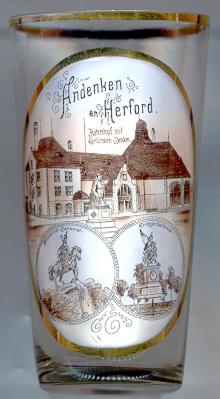

|
| DEUTSCHLAND | GERMANY |
| Bundesland: Nordrhein-Westfalen | North Rhine-Westphalia |
| Regierungsbezirk: Detmold | |
| Kreis: Herford |
Herford is situated at an elevation of 56 m at the river Werre in northeastern Westphalia.
In AD 789 a monastery for the daughters of the saxon high nobility was founded by Waltger (Wolderus, b.ca.725, d.825, Saint since the 11th century) in Müdehorst
(today part of Bielefeld).
This monastery was moved around 800 to Herivurth (today Oldenhervorde) at the confluence of the rivers Aa and Werre. The monastery
obtained the status of an Imperial monastery by Emperor Ludwig the Pious who also donated large estates for the support of the monastery.
 After King Ludwig the German confirmed the privileges of the monastery in 851 the village of Herford slowly began developed around the monastery.
The privileges were again confirmed by King Heinrich I in 927, King (later Emperor) Otto the Great in 973, King Konrad III in 1147 and Emperor Friedrich I Barbarossa in 1152.
The monastery became immediate to Pope Hadrian around 1155. The status of a town was granted to Herford around 1170. From 1342 Herford
was member of the Hanse, the union of the most important German trading cities of the time. The abbey St. Dionys with its treasury and the bones of the Saxon Duke Widukind (Wittekind, ca.730–800)
was moved to the church St. Johannis in Herford in 1414. Herford's independence ended in 1648 (Peace of Westphalia) when it became part of Brandenburg-Prussia.
The Thirty Years' War and the economical policy of Brandenburg-Prussia in the 17th and 18th century ended the flourishing period of the town.
With the beginning of the industrialisation at the beginning of the 19th century Herford gained importance again. The first cotton mill with water turbines and gas lighting was opened in 1808 in the
former monastery which had been closed in 1802. Herford became the seat of a district within the prussian province of Westphalia in 1813.
Twenty former Hanse cities in Westphalia renewed their cooperation in 1983 (Westfälischer Hansebund with seat in Herford).
After King Ludwig the German confirmed the privileges of the monastery in 851 the village of Herford slowly began developed around the monastery.
The privileges were again confirmed by King Heinrich I in 927, King (later Emperor) Otto the Great in 973, King Konrad III in 1147 and Emperor Friedrich I Barbarossa in 1152.
The monastery became immediate to Pope Hadrian around 1155. The status of a town was granted to Herford around 1170. From 1342 Herford
was member of the Hanse, the union of the most important German trading cities of the time. The abbey St. Dionys with its treasury and the bones of the Saxon Duke Widukind (Wittekind, ca.730–800)
was moved to the church St. Johannis in Herford in 1414. Herford's independence ended in 1648 (Peace of Westphalia) when it became part of Brandenburg-Prussia.
The Thirty Years' War and the economical policy of Brandenburg-Prussia in the 17th and 18th century ended the flourishing period of the town.
With the beginning of the industrialisation at the beginning of the 19th century Herford gained importance again. The first cotton mill with water turbines and gas lighting was opened in 1808 in the
former monastery which had been closed in 1802. Herford became the seat of a district within the prussian province of Westphalia in 1813.
Twenty former Hanse cities in Westphalia renewed their cooperation in 1983 (Westfälischer Hansebund with seat in Herford).
The  railway station [top] was built in 1847 when the railway line from Cologne to Minden was opened.
railway station [top] was built in 1847 when the railway line from Cologne to Minden was opened.
The  Kurfürsten-Denkmal (Elector's monument) in front of the railway station was melted down in 1942.
Kurfürsten-Denkmal (Elector's monument) in front of the railway station was melted down in 1942.
The  Wittekind monument [bottom left] was created in 1899 by the Berlin sculptor Heinrich Wefing.
The bronze monument was melted down in 1942. After the war it was re-erected (date not found).
Wittekind monument [bottom left] was created in 1899 by the Berlin sculptor Heinrich Wefing.
The bronze monument was melted down in 1942. After the war it was re-erected (date not found).
The  Kriegerdenkmal (Soldier's monument) [bottom right] was erected on the old market square
in 1879. In 1965 it was moved to the old cemetery.
Kriegerdenkmal (Soldier's monument) [bottom right] was erected on the old market square
in 1879. In 1965 it was moved to the old cemetery.
![[scale]](lineal.jpg)